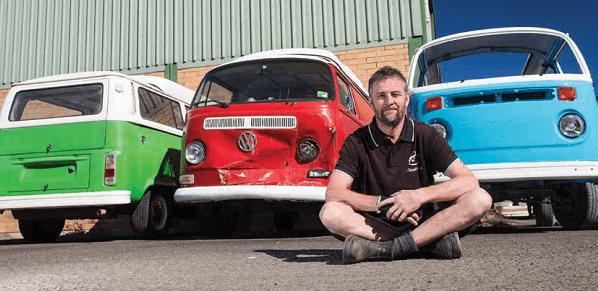With VW Kombis fetching classic Porsche or Ferrari money these days, Nick Parker-Davies’ Kombi Shop is a true dream factory.
Tucked away behind the main road between the Sunshine Coast tourist towns of Noosa and Eumundi is a VW Kombi dream factory. The Kombi Shop is the largest classic Volkswagen restoration business in the Southern Hemisphere, and a place where owners from across Australia send their iconic VWs for better-than-new transformations.
On arrival I’m greeted by a range of classic Kombis, Beetles, buggies and other air-cooled classics resting in the sunshine. Some are basket cases, others look ripe for freshening up and a few are in the early stages of being brought back to life. There are three sheds where I hear panel bashing and air guns firing; this is a buzzing, busy place and everyone at work greets me with a smile and a quick chat. It’s hard not to smile when you see a Kombi – it’s obviously the same when you work on them.

The shop is owned by Nick Parker-Davies, who cut his teeth working in a large body shop in the UK. “I got a taste for the resto side of things there, then set up my own mechanical shop,” he said. “I was driving with the family one summer’s day and a split-screen Kombi came along. It was just the coolest thing and I said we just have to have one.”
Nick bought an old split-screen Kombi wreck for about $200 (this was 1992), fixed it up and tried to find a camping interior. “I couldn’t believe there was nothing available; I just couldn’t buy a Kombi interior,” he said. So Nick designed the interior he wanted, had a cabinetmaker build it and give him the templates, and his Kombi promptly won one of the UK’s largest car shows. Sniffing the business potential, he printed up business cards, went to another show and took nearly 20 orders from VW owners.
He founded Bus Guts to cover Kombi bespoke interior work, and owners were soon asking for mechanical and paintwork as well. After moving to the Sunshine Coast in 2005 Nick continued doing what he knew and loved, establishing the Kombi Shop in a single shed just outside Noosa. Today the vast majority of work is still on the lovable buses, but a few other classic air-cooled VWs pass through as well.
“Within about three years of setting up there were eight of us working in three sheds,” Nick said. “It’s such a niche market in Australia and it didn’t take long for people to find out who we were.”
It’s a proper one-stop shop. Aside from insurance work where a crunched Kombi will be repaired, any restoration has to be the full monty. “We made the decision not to do anything but bare metal restorations, and not a single job is farmed out,”
“It’s Such A Niche Market In Australia And It Didn’t Take Long For People To Find Out Who We Were.”
Nick said. That means the workers – all permanent, no casuals – are divided into set areas such as fabrication for rust and panel work, body shop for the body work and paint, and the mechanical side for engine building, gearboxes and actually screwing everything back together.
“Everybody is capable of jumping ship into another department if there’s holiday leave or illness, as production can’t stop,” Nick said. “It’s taken a good eight years to fine tune it with the right people and the right investment back into the business to offer everyone a secure job. Everything’s shared, morale is fabulous and everybody’s extremely proud of what we produce.”
After 15 years in business Nick knows Kombi Shop is a well-established and trusted operation, and it needs to be when restorations of these classic VWs often cost over $100,000. “We make sure we do it right every time,” Nick said. “All vehicle bodies are stripped and sandblasted, as this is the only way to get a true picture of the condition of the body. Kombis are collector’s vehicles, pure investments, especially the earlier split-screens. It’s a win-win situation. If you like them and have the money you can buy one, enjoy it and you’ll never lose money on it. I own about ten of them and still love them.”

A 1960 Australian-delivered 23-window Kombi Samba Bus sold for $202,000 in 2015, highlighting what blue-chip investments these old VWs are. “The most expensive parts of the restoration are panels, body and paint,” Nick said. “To get your average Kombi from wreck stage to painted body takes approximately 1000 hours. Then there’s trim, mechanical and build. We can get good quality parts and panels through my contacts, and the only really hard stuff to find are the final little daft bits like door catches and mechanisms.”
Little wonder the 12 or so turnkey Kombis that leave this shop each year command six-figure sums for their full restos, but Nick’s shop is busy for a reason. There’s demand here, and it’s a vehicle to cherish.
“A Kombi is one of the only classic vehicles the whole family, including the kids, are on board with,” Nick said. “It’s fun, practical, you can go on holiday in it and it’s a sound investment. Everybody’s involved in choosing colours, trim, cabinets and everything else to produce their dream. I fell in love with them one sunny summer’s day, and the best satisfaction is when we pull the covers off a finished one for a customer, knowing they’ll be having the same feeling.”


